Order-4 icosahedral honeycomb
| Order-4 icosahedral honeycomb | |
|---|---|
| Type | Regular honeycomb |
| Schläfli symbols | {3,5,4} |
| Coxeter diagrams | |
| Cells | {3,5} |
| Faces | {3} |
| Edge figure | {4} |
| Vertex figure | {5,4}  |
| Dual | {4,5,3} |
| Coxeter group | [3,5,4] |
| Properties | Regular |
In the geometry of hyperbolic 3-space, the order-5 icosahedral honeycomb is a regular space-filling tessellation (or honeycomb) with Schläfli symbol {3,5,4}.
Geometry
It has four icosahedra {3,5} around each edge. All vertices are ultra-ideal (existing beyond the ideal boundary) with infinitely many icosahedra existing around each vertex in an order-4 pentagonal tiling vertex arrangement.
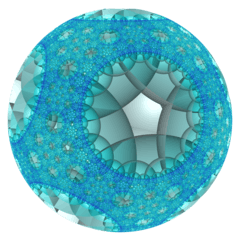 Poincaré disk model (Cell centered) |
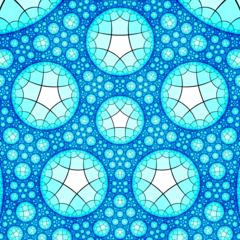 Ideal surface |
It has a second construction as a uniform honeycomb, Schläfli symbol {3,51,1}, Coxeter diagram, ![]()
![]()
![]()
![]()
![]()
Related polytopes and honeycombs
It a part of a sequence of regular polychora and honeycombs with icosahedral cells: {3,5,p}
| {3,5,p} polytopes | |||||||||||
|---|---|---|---|---|---|---|---|---|---|---|---|
| Space | H3 | ||||||||||
| Form | Paracompact | Noncompact | |||||||||
| Name | {3,5,3} |
{3,5,4} |
{3,5,5} |
{3,5,6} |
{3,5,7} |
{3,5,8} |
... {3,5,∞} | ||||
| Image |  |
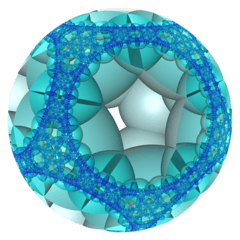 |
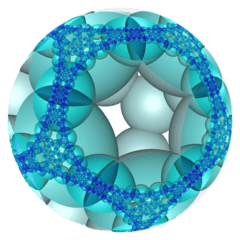 |
 |
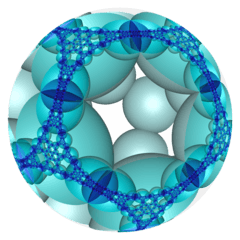 |
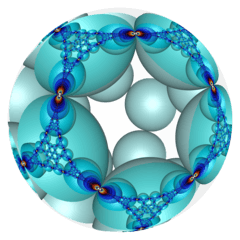 | |||||
| Vertex figure |
 {5,3} |
 {5,4} |
 {5,5} |
 {5,6} |
 {5,6} |
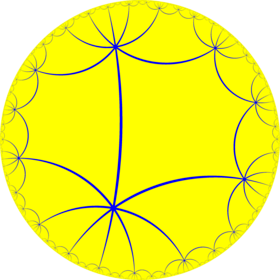 {5,6} |
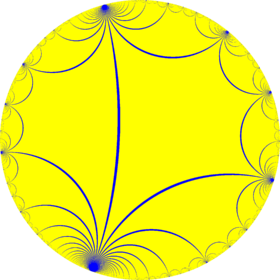 {5,∞} | ||||
Order-5 icosahedral honeycomb
| Order-5 icosahedral honeycomb | |
|---|---|
| Type | Regular honeycomb |
| Schläfli symbols | {3,5,5} |
| Coxeter diagrams | |
| Cells | {3,5} |
| Faces | {3} |
| Edge figure | {5} |
| Vertex figure | {5,5} |
| Dual | {5,5,3} |
| Coxeter group | [3,5,5] |
| Properties | Regular |
In the geometry of hyperbolic 3-space, the order-5 icosahedral honeycomb is a regular space-filling tessellation (or honeycomb) with Schläfli symbol {3,5,5}. It has five icosahedra, {3,5}, around each edge. All vertices are ultra-ideal (existing beyond the ideal boundary) with infinitely many icosahedra existing around each vertex in an order-5 pentagonal tiling vertex arrangement.
 Poincaré disk model (Cell centered) |
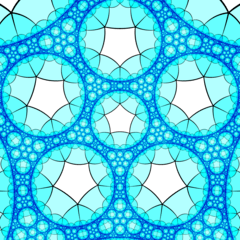 Ideal surface |
Order-6 icosahedral honeycomb
| Order-6 icosahedral honeycomb | |
|---|---|
| Type | Regular honeycomb |
| Schläfli symbols | {3,5,6} {3,(5,∞,5)} |
| Coxeter diagrams | |
| Cells | {3,5} |
| Faces | {3} |
| Edge figure | {6} |
| Vertex figure | {5,6} |
| Dual | {6,5,3} |
| Coxeter group | [3,5,6] |
| Properties | Regular |
In the geometry of hyperbolic 3-space, the order-6 icosahedral honeycomb is a regular space-filling tessellation (or honeycomb) with Schläfli symbol {3,5,6}. It has six icosahedra, {3,5}, around each edge. All vertices are ultra-ideal (existing beyond the ideal boundary) with infinitely many icosahedra existing around each vertex in an order-6 pentagonal tiling vertex arrangement.
 Poincaré disk model (Cell centered) |
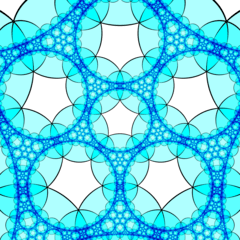 Ideal surface |
Order-7 icosahedral honeycomb
| Order-7 icosahedral honeycomb | |
|---|---|
| Type | Regular honeycomb |
| Schläfli symbols | {3,5,7} |
| Coxeter diagrams | |
| Cells | {3,5} |
| Faces | {3} |
| Edge figure | {7} |
| Vertex figure | {5,7} |
| Dual | {7,5,3} |
| Coxeter group | [3,5,7] |
| Properties | Regular |
In the geometry of hyperbolic 3-space, the order-7 icosahedral honeycomb is a regular space-filling tessellation (or honeycomb) with Schläfli symbol {3,5,7}. It has seven icosahedra, {3,5}, around each edge. All vertices are ultra-ideal (existing beyond the ideal boundary) with infinitely many icosahedra existing around each vertex in an order-7 pentagonal tiling vertex arrangement.
 Poincaré disk model (Cell centered) |
 Ideal surface |
Order-8 icosahedral honeycomb
| Order-8 icosahedral honeycomb | |
|---|---|
| Type | Regular honeycomb |
| Schläfli symbols | {3,5,8} |
| Coxeter diagrams | |
| Cells | {3,5} |
| Faces | {3} |
| Edge figure | {8} |
| Vertex figure | {5,8} |
| Dual | {8,5,3} |
| Coxeter group | [3,5,8] |
| Properties | Regular |
In the geometry of hyperbolic 3-space, the order-8 icosahedral honeycomb is a regular space-filling tessellation (or honeycomb) with Schläfli symbol {3,5,8}. It has eight icosahedra, {3,5}, around each edge. All vertices are ultra-ideal (existing beyond the ideal boundary) with infinitely many icosahedra existing around each vertex in an order-8 pentagonal tiling vertex arrangement.
 Poincaré disk model (Cell centered) |
Infinite-order icosahedral honeycomb
| Infinite-order icosahedral honeycomb | |
|---|---|
| Type | Regular honeycomb |
| Schläfli symbols | {3,5,∞} {3,(5,∞,5)} |
| Coxeter diagrams | |
| Cells | {3,5} |
| Faces | {3} |
| Edge figure | {∞} |
| Vertex figure | {5,∞} {(5,∞,5)} |
| Dual | {∞,5,3} |
| Coxeter group | [∞,5,3] [3,((5,∞,5))] |
| Properties | Regular |
In the geometry of hyperbolic 3-space, the infinite-order icosahedral honeycomb is a regular space-filling tessellation (or honeycomb) with Schläfli symbol {3,5,∞}. It has infinitely many icosahedra, {3,5}, around each edge. All vertices are ultra-ideal (existing beyond the ideal boundary) with infinitely many icosahedra existing around each vertex in an infinite-order triangular tiling vertex arrangement.
 Poincaré disk model (Cell centered) |
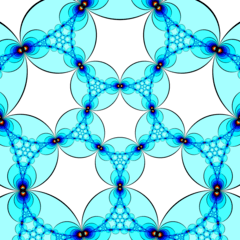 Ideal surface |
It has a second construction as a uniform honeycomb, Schläfli symbol {3,(5,∞,5)}, Coxeter diagram, ![]()
![]()
![]()
![]()
![]()
![]()
![]()
![]()
![]()
![]()
![]()
![]()
![]()
See also
References
- Coxeter, Regular Polytopes, 3rd. ed., Dover Publications, 1973. ISBN 0-486-61480-8. (Tables I and II: Regular polytopes and honeycombs, pp. 294–296)
- The Beauty of Geometry: Twelve Essays (1999), Dover Publications, LCCN 99-35678, ISBN 0-486-40919-8 (Chapter 10, Regular Honeycombs in Hyperbolic Space) Table III
- Jeffrey R. Weeks The Shape of Space, 2nd edition ISBN 0-8247-0709-5 (Chapters 16–17: Geometries on Three-manifolds I,II)
- George Maxwell, Sphere Packings and Hyperbolic Reflection Groups, JOURNAL OF ALGEBRA 79,78-97 (1982)
- Hao Chen, Jean-Philippe Labbé, Lorentzian Coxeter groups and Boyd-Maxwell ball packings, (2013)
- Visualizing Hyperbolic Honeycombs arXiv:1511.02851 Roice Nelson, Henry Segerman (2015)
External links
- John Baez, Visual insights: {7,3,3} Honeycomb (2014/08/01) {7,3,3} Honeycomb Meets Plane at Infinity (2014/08/14)
- Danny Calegari, Kleinian, a tool for visualizing Kleinian groups, Geometry and the Imagination 4 March 2014.